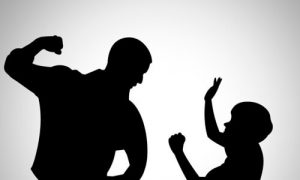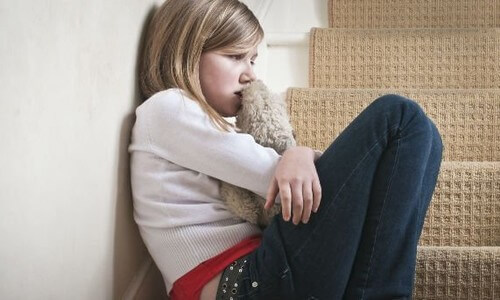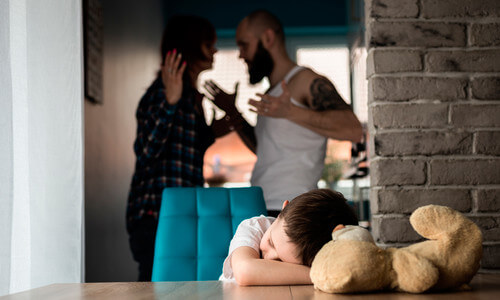Child Abuse: What Is It and What Are Its Effects?

The healthy upbringing of a child doesn’t only depend on having a home, food, and a good education. Of course, having these needs met every day is vital.
However, these factors alone don’t make for a happy or healthy upbringing if the child is being mistreated. A child needs much more in order to grow and be happy.
Besides feeding, sheltering and educating your child, it’s also vital that you care for his emotional development. In the following article, you’ll find all you need to know about child abuse.
We’ll talk about the different types of child abuse, and the most common reasons behind it.
We’ll also look at the impact of child abuse on infant development, and how to avoid it.
Types of child abuse
Child abuse can take on many forms and therefore causes different types of damage.
As for the classification of different types of abuse, every situation is different and depends on a variety of circumstances.
It’s worth mentioning that abuse is a complex reality that involves diverse factors. However, child abuse is never justifiable under any circumstance.
Physical abuse
This is the most well-known type of abuse. It refers to any type of injury deliberately inflicted on another person. It can include hitting, cutting, and other types of more serious torture.
When physical abuse takes place in the family, it usually comes from one or both parents. Generally speaking, physical abuse is linked to alcoholism, drug addiction, financial problems, neurosis, and other issues.

Psychological abuse
This type of child abuse appears in different environments. However, given its nature, the aggressor is usually someone that is close to the child. It may be a parent, grandparent, teacher, etc.
Psychological abuse usually presents itself in the form of threats, making fun, constant criticizing of the child’s defects, derogatory language, and also intimidation, manipulation and extortion.
Sexual abuse
Sexual abuse in children shares many of the characteristics listed above when referring to physical and psychological abuse. However, the nature of sexual abuse and the impact of this type of abuse on the child are much more serious.
This type of abuse usually comes from someone in the child’s circle of trust – be it a family member, relative, or another trusted person.
Sexual abuse has a damaging impact on a child’s psycho-emotional development. This type of abuse leaves short-, medium- and long-term effects.
According to a number of studies, the effects of sexual abuse include depression, suicide, drug addiction, various psychological disorders, etc.
Abandonment or negligence
This type of abuse takes places when a parent or guardian negates an element that the child needs. It includes negligence in a specific area, such as food, hygiene, medical care, safety. And it also refers to the total abandonment of the child.
Abandonment can occur in different ways. Either the parent or guardian leaves the home, or he or she leaves the child alone somewhere else to fend for himself.
Abandonment has negative effects on a child’s psychological development. This is in addition to the direct damage already inflicted by the negligence itself (malnutrition, lack of medical attention or education, preventable accidents, etc).
Abandonment and negligence exposes children to environments that are toxic and harmful for their development.
Abuse is not exclusive
It’s important to point out that the above-mentioned categories aren’t exclusive. In other words, a child can be exposed to more than one type of abuse at the same time.
Abusive individuals often inflict more than one type of abuse on their victims.

The impact of child abuse
The effects of child abuse are profoundly negative. As expressed previously, child abuse is harmful and completely unjustifiable.
During childhood, interpersonal relationships have a decisive impact on a child’s development and well-being. With this in mind, healthy and positive relationships are absolutely fundamental during childhood.
We recommend using positive child-raising methods and using the techniques described in attachment parenting.
Incorporate these methodologies rather than resorting to punishment, violence and other types of abuse.
Attachment theory combines an empirical focus with a humanistic one. It takes from evolutive biology, psychology and psychoanalysis. Therefore, attachment theory provides a very complete model to assist you.
The theory explains the way in which the emotional bond between parents or guardians and infants forms. It explains how this bond allows the child to initiate the collection of information about behavior patterns.
In other words, external stimulants allow your child to acquire models that enable him to cope in the environment around him.
Child abuse distorts a child’s perceptions and coping abilities. For that reason, child abuse is a serious issue that has major negative effects on a child’s psychological development.
Child abuse makes it very difficult for victims to form and enjoy healthy relationships with others.
All cited sources were thoroughly reviewed by our team to ensure their quality, reliability, currency, and validity. The bibliography of this article was considered reliable and of academic or scientific accuracy.
- Santana-Tavira, R., Sánchez-Ahedo, R., & Herrera-Basto, E. (1998). El maltrato infantil: un problema mundial. https://www.scielosp.org/article/spm/1998.v40n1/58-65/es/
- Morelato, G. (2011). Maltrato infantil y desarrollo: hacia una revisión de los factores de resiliencia. Pensamiento psicológico, 9(17), 83-96. http://www.scielo.org.co/scielo.php?script=sci_arttext&pid=S1657-89612011000200008
- Francia Reyes, M. E. (2003). Maltrato infantil: Un problema de todos. Revista cubana de medicina general integral, 19(1), 0-0. http://scielo.sld.cu/scielo.php?script=sci_arttext&pid=S0864-21252003000100009
- Robaina Suárez, G. (2001). El maltrato infantil. Revista Cubana de medicina general integral, 17(1), 74-80. http://scielo.sld.cu/scielo.php?script=sci_arttext&pid=S0864-21252001000100011
This text is provided for informational purposes only and does not replace consultation with a professional. If in doubt, consult your specialist.
